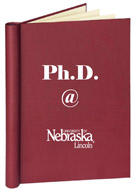Graduate Studies, UNL

Dissertations and Doctoral Documents from University of Nebraska-Lincoln, 2023–
First Advisor
Jeffrey E. Shield
Degree Name
Doctor of Philosophy (Ph.D.)
Committee Members
Rebecca Lai, Yongfeng Lu, Bai Cui, Abdelghani Laraoui
Department
Engineering
Date of this Version
7-2024
Document Type
Dissertation
Citation
A dissertation presented to the faculty of the Graduate College of the University of Nebraska in partial fulfillment of requirements for the degree of Doctor of Philosophy
Major: Materials Engneering
Under the supervision of Professor Jeffrey E. Shield
Lincoln, Nebraska, July 2024
Abstract
Spin crossover (SCO) complexes have unique properties of switching their spin state upon perturbations like temperature, pressure, light, etc. Along with the spin state, different properties vary like structural, electrical, magnetic, optical properties. This enables these materials to be potentially used in various applications like molecular electronics, memory devices, switching devices, sensors and many more. To incorporate spin crossover materials into devices with efficient performance, the electrical behavior needs to be understood. This dissertation aims to investigate the effect of crystal structure on the electrical properties of iron(II) triazole spin crossover complex and how it can be modified for better performance.
In chapter two, materials for the experiments and various experimental methods are discussed. The third chapter of this dissertation reports two polymorphs of iron(II) triazole- nanoparticles and nanorods, and their crystallographic investigation. It also contains electrical conductivity studies on polymorphs. It was observed that conductivity changes with morphology and crystal properties.
The fourth chapter emphasizes how the conductivity changes with localized strain application on one of the polymorphs and it establishes a relationship between applied strain and conductivity. It was found that conductivity increases up to a certain strain and then it decreases with increasing strain. To manipulate this strain-dependent conductivity, the polymorph was incorporated with piezoelectric PVDF film to make a layer-by-layer composite film, which is reported in chapter five. It was found that the spin crossover couples with the piezoelectricity of the PVDF film, and the conductivity of the system increases. This will make the layer-by-layer film potential for future applications in different sensors and switches.
Advisor: Jeffrey E. Shield
Recommended Citation
Mahbub, Rifat, "Electrical and Morphological Investigation of a Fe(II) Based Spin Crossover Complex and Its Composite" (2024). Dissertations and Doctoral Documents from University of Nebraska-Lincoln, 2023–. 176.
https://digitalcommons.unl.edu/dissunl/176


Comments
Copyright 2024, Rifat Mahbub. Used by permission